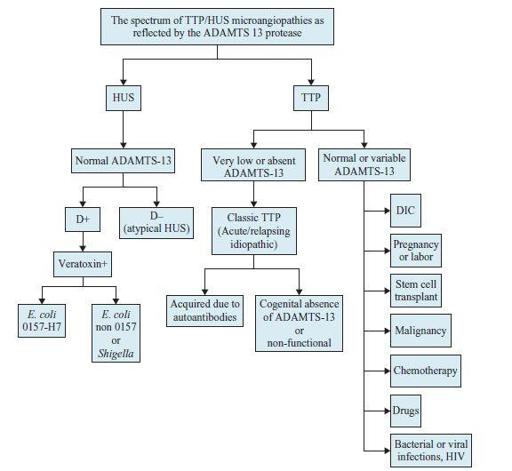Wallach's Interpretation of Diagnostic Tests: Pathways to Arriving at a Clinical Diagnosis (412 page)
Authors: Mary A. Williamson Mt(ascp) Phd,L. Michael Snyder Md

BOOK: Wallach's Interpretation of Diagnostic Tests: Pathways to Arriving at a Clinical Diagnosis
11.65Mb size Format: txt, pdf, ePub
THROMBOTIC THROMBOCYTOPENIC PURPURA/HEMOLYTIC UREMIC SYNDROME (TTP/HUS)
Definition
TTP and HUS are severe thrombotic microangiopathies characterized by systemic platelet aggregates causing ischemia in multiple organ systems, thrombocytopenia, and fragmentation of red cells. These conditions are expressed by microangiopathic hemolytic anemia, thrombocytopenia, and occasionally neurologic, and renal involvement. TTP and HUS are disorders with many similarities. There are, however, sufficient differences between these conditions to be considered separately.
Who Should Be Suspected?
TTP
Classically, patients with TTP were described as presenting with the following pentad: fever, microangiopathic hemolytic anemia, thrombocytopenia, and impaired renal and neurologic function. In reality, most patients have some, but not all, of the components of the pentad, and the pentad criteria are no longer used.
TTP may be congenital, or acquired, resulting from antibodies against ADAMTS 13 (Figure
9-4
). The hereditary form, much less common, is known as the Upshaw-Schulman syndrome; it is the result of homozygous or compound heterozygous ADAMTS13 gene mutation.

Figure 9–4
The spectrum of thrombotic thrombocytopenic purpura (TTP)/hemolytic uremic syndrome (HUS) microangiopathies as reflected by the ADAMTS 13 protease. E. coli, Escherichia coli.
ADAMTS13 is a metalloprotease that cleaves very large molecular weight components of the pro-vWF, thereby reducing the propensity of the pro-vWF to agglutinate platelets in vivo. Its absence results in release into the circulation of thrombogenic very high molecular weight vWF multimers.
TTP can be broadly divided into two categories: the acute idiopathic (classic) TTP, seen in about one third of cases, and secondary TTP (in two thirds of cases), those in which a causative condition or agent can be identified: bacterial or viral (including AIDS) infections, pregnancy (especially during the third trimester and postpartum period), certain drugs: ADP inhibitors of platelet function (ticlopidine [rarely used now] and infrequently clopidogrel), quinine, mitomycin C, cisplatinum, bleomycin, α-interferon, cyclosporine, tacrolimus, other immunosuppressive or chemotherapeutic agents, disseminated malignancy, and allogeneic stem cell transplantation. Classic TTP occurs primarily in adults and has a higher incidence in women.
HUS
HUS is predominantly a pediatric disease. It presents commonly in a child who recently had abdominal pain and bloody diarrhea and develops acute microangiopathic hemolytic anemia, thrombocytopenia, and acute renal failure. It is a complication of an infection caused by a verotoxin-producing strain of
E. coli
0157:H7 (most common cause in the United States) or
Shigella
(see Figure
9-4
). In different countries, other bacteria have been found to be the etiologic agent in HUS. HUS is a self-limited disease.
Atypical HUS, which comprises approximately 10% of cases, is a term now reserved for HUS caused by complement regulatory abnormalities. In these patients, a low serum C3 level may be detected.
Laboratory Findings
TTP
CBC.
Other books
Invaded by Melissa Landers
Bitter Bonds by Lex Valentine
The Gift of Fear: Survival Signals that Protect us from Violence by Gavin De Becker
Belladonna at Belstone by Michael Jecks
Wicked Obsession (Bend to My Will #6) by Emily Jane Trent
The Sisters by Robert Littell
Railsea by China Mieville
The Golden Barbarian by Iris Johansen
Clear by Fire by Joshua Hood
Mary Queen of Scotland & the Isles by Margaret George
